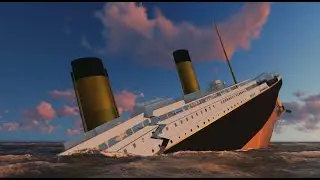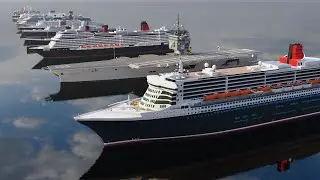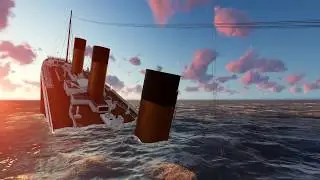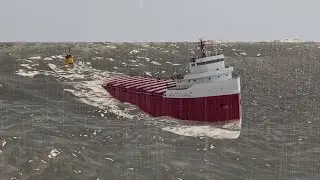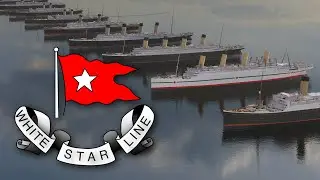Sinking of the SS Edmund Fitzgerald
SS Edmund Fitzgerald was an American Great Lakes freighter that sank in Lake Superior during a storm on November 10, 1975, with the loss of the entire crew of 29 men. When launched on June 7, 1958, she was the largest ship on North America's Great Lakes, and she remains the largest to have sunk there. She was located in deep water on November 14, 1975, by a U.S. Navy aircraft detecting magnetic anomalies, and found soon afterwards to be in two large pieces.
For 17 years, Edmund Fitzgerald carried taconite iron ore from mines near Duluth, Minnesota, to iron works in Detroit, Toledo, and other Great Lakes ports. As a workhorse, she set seasonal haul records six times, often breaking her own record. Captain Peter Pulcer was known for piping music day or night over the ship's intercom while passing through the St. Clair and Detroit rivers (between lakes Huron and Erie), and entertaining spectators at the Soo Locks (between Lakes Superior and Huron) with a running commentary about the ship. Her size, record-breaking performance, and "DJ captain" endeared Edmund Fitzgerald to boat watchers.
Carrying a full cargo of ore pellets with Captain Ernest M. McSorley in command, she embarked on her ill-fated voyage from Superior, Wisconsin, near Duluth, on the afternoon of November 9, 1975. En route to a steel mill near Detroit, Edmund Fitzgerald joined a second taconite freighter, SS Arthur M. Anderson. By the next day, the two ships were caught in a severe storm on Lake Superior, with near hurricane-force winds and waves up to 35 feet (11 m) high. Shortly after 7:10 p.m., Edmund Fitzgerald suddenly sank in Canadian (Ontario) waters 530 feet (88 fathoms; 160 m) deep, about 17 miles (15 nautical miles; 27 kilometers) from Whitefish Bay near the twin cities of Sault Ste. Marie, Michigan, and Sault Ste. Marie, Ontario—a distance Edmund Fitzgerald could have covered in just over an hour at her top speed.
Edmund Fitzgerald previously reported being in significant difficulty to Arthur M. Anderson: "I have a bad list, lost both radars. And am taking heavy seas over the deck. One of the worst seas I've ever been in." However, no distress signals were sent before she sank; Captain McSorley's last (7:10 P.M.) message to Arthur M. Anderson was, "We are holding our own." Her crew of 29 perished, and no bodies were recovered. The exact cause of the sinking remains unknown, though many books, studies, and expeditions have examined it. Edmund Fitzgerald may have been swamped, suffered structural failure or topside damage, experienced shoaling, or suffered from a combination of these.
The disaster is one of the best-known in the history of Great Lakes shipping. Gordon Lightfoot made it the subject of his 1976 hit song "The Wreck of the Edmund Fitzgerald" after reading an article, "The Cruelest Month", in the November 24, 1975, issue of Newsweek. The sinking led to changes in Great Lakes shipping regulations and practices that included mandatory survival suits, depth finders, positioning systems, increased freeboard, and more frequent inspection of vessels.
Model made by: Lucas Gustaffson
https://3dwarehouse.sketchup.com/mode...
#SSEdmundFitzgerald #Sinking #CaljuCotcas
Смотрите видео Sinking of the SS Edmund Fitzgerald онлайн, длительностью часов минут секунд в хорошем качестве, которое загружено на канал CaljuCotcas 20 Июнь 2021. Делитесь ссылкой на видео в социальных сетях, чтобы ваши подписчики и друзья так же посмотрели это видео. Данный видеоклип посмотрели 2,817,852 раз и оно понравилось 14 тысяч посетителям.










